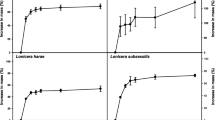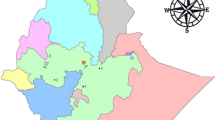Abstract
Recently, a clover-breeding program has been launched using the genetic diversity of wild clover species (Trifolium spp.) in order to release new clover germplasms in Iran. Seed dormancy was the major limitation for using these germplasms. To resolve this issue, 12 accessions of T. campestre Scherb., T. diffusum Ehrh., T. echinatum M. Bieb., T. hirtum All., and T. lappaceum L., wild species, together with cultivated species (T. resupinatum L.) which had been selected from previous studies were subjected in this research. Clover seeds were treated by two thermal (2 and 21 °C) and two scarification treatments, in a factorial design. F-test indicated a significant difference (p < 0.00) for germination rate between scarified and non-scarified treatments. However, the cold treatment did not increase the seed germination rate in the non-scarified groups, even though the seeds were transferred from 2 to 21 °C after 4 weeks of seeding. Whereas, the seed coat scarification had a high positive significant effect on seed germination rate. It means the seed dormancy was physical rather than physiological. Based on of Duncan’s test and cluster analysis, the accessions were grouped into three classes in accordance with variation in seed hardness: i-accessions of T. resupinatum which showed no seed coat hardness, ii- accessions of T. campestre with a slightly degree of seed hardness, and cluster iii- containing the accessions of four wild species with severe seed hardness. In addition, there was diversity in seed germination for different seed coat colors. Since brown seeds showed more water permeable coats, breeding for this color type leads to soft-coat seeds. Finally, it is proposed that the seed coat scarification is an essential process before sowing of wild clovers' seeds.


Similar content being viewed by others
References
Abbasi M (2009) Genetic diversity of clover genetic resources held by National Plant Gene Bank of Iran with emphasis on agronomic traits. Iran J Rangel For Plant Breed Genet Res 17(1):70–87
Abbasi M, Zamanian M, Nadali F (2011) New pre-breeding genetic resources of Iranian wild clovers for using in agronomic systems. Iran J Rangel For Plant Breed Genet Res 18(2):317–328
Abbasi MR (2008) Genetic diversity of persian clover (Trifolium resupinatum) gene pools in National Plant Gene Bank of Iran. Iran J Rangel For Plant Breed Genet Res 16(1):37–50
Abbasi MR, Hassanzadeh A, Mahdipour A, Anahid S, Safari S (2019) Forage yield in some Iranian wild trifolium genetic resources under different climatic and irrigation conditions. J Agric Sci Technol 21(4):993–1004
Abbasi MR, Zamanian M (2008) Classification of selected multi-cut Persian clover germplasm of National Plant Genebank based on agronomic traits. Pajouhesh-va-Sazandegi 21(2):63–80
Abdullah WD, Powell AA, Matthews S (1991) Association of differences in seed vigour in long bean (Vigna sesquipedalis) with testa colour and imbibition damage. J Agric Sci 116(02):259–264. https://doi.org/10.1017/S0021859600077662
Ahmadi K, Gholizadeh H, Ebadzadeh HR, Hossienpour R, Hatami F, Fazli B et al (2015) Agricultural statistics: I. Agronomy crops, vol I. Ministry of Agriculture, Iran, Tehran
Baskin JM, Baskin CC, Li X (2000) Taxonomy, anatomy and evolution of physical dormancy in seeds. Plant Species Biol 15(2):139–152
Baskin JM, Davis BH, Baskin CC, Gleason SM, Cordell S (2004) Physical dormancy in seeds of Dodonaea viscosa (Sapindales, Sapindaceae) from Hawaii. Seed Sci Res 14(01):81–90. https://doi.org/10.1079/SSR2003157
Baskin JM, Nan X, Baskin CC (1998) A comparative study of seed dormancy and germination in an annual and a perennial species of Senna (Fabaceae). Seed Sci Res 8(04):501–512. https://doi.org/10.1017/S0960258500004475
Cocks P (1993) Seed and seedling dynamics over four consecutive years from a single seed set of six annual medics (Medicago SPP) in North Syria. Exp Agric 29(04):461–472
Fyad-Lameche F, Bellatar G, Bouabdallah S, Yahia N (1996) Between and within species variation in annual Medicago species. Cahiers Options Mediterraneennes (CIHEAM).
Hu XW, Wang YR, Wu YP, Baskin CC (2009) Role of the lens in controlling water uptake in seeds of two Fabaceae ( Papilionoideae) species treated with sulphuric acid and hot water. Seed Sci Res 19(02):73–80. https://doi.org/10.1017/S0960258509301099
Jayasuriya KMGG, Baskin JM, Baskin CC (2009) Sensitivity cycling and its ecological role in seeds with physical dormancy. Seed Sci Res 19(01):3–13. https://doi.org/10.1017/S096025850818730X
Keshtkar A, Keshtkar H, Razavi S, Dalfardi S (2010) Methods to break seed dormancy of Astragalus cyclophyllon. Afr J Biotechnol 7(21):3874–3877
Kİr B, Topcu G, Budak B, Salman A, Yİlmaz M, Özkan S (2016) A preliminary study on the effect of different seed coat treatments on the germination of Ciliate Medick (Medicago ciliaris L.). Radovi Poljoprivrednog Fakulteta Univerziteta u Sarajevu (Works of the Faculty of Agriculture University of Sarajevo), 61(1):296–299
Lacerda DR, Lemos Filho JP, Goulart MF, Ribeiro RA, Lovato MB (2004) Seed-dormancy variation in natural populations of two tropical leguminous tree species: Senna multijuga (Caesalpinoideae) and Plathymenia reticulata (Mimosoideae). Seed Sci Res 14(02):127–135
Martens H, Jakobsen HB, Lyshede OB (1995a) Development of the strophiole in seeds of white clover (Trifolium repens L.). Seed Sci Res 5(03):171–176. https://doi.org/10.1017/S0960258500002798
Matilla A, Gallardo M, Puga-Hermida MI (2005) Structural, physiological and molecular aspects of heterogeneity in seeds: a review. Seed Sci Res 15(02):63–76
Mira S, Schnadelbach A, Correa EC, Pérez-García F, González-Benito ME (2017) Variability of physical dormancy in relation to seed mechanical properties of three legume species. Seed Sci Technol 45(3):540–556. https://doi.org/10.15258/sst.2017.45.3.11
Mohamed-Yasseen Y, Barringer SA, Splittstoesser WE, Costanza S (1994) The role of seed coats in seed viability. Bot Rev 60(4):426–439. https://doi.org/10.1007/bf02857926
Moreno-Casasola P, Grime JP, Martínez ML (1994) A comparative study of the effects of fluctuations in temperature and moisture supply on hard coat dormancy in seeds of coastal tropical legumes in Mexico. J Trop Ecol 10(01):67–86. https://doi.org/10.1017/S0266467400007720
Morris J, Greene S (2001) Defining a Multiple-Use Germplasm Collection for the Genus Trifolium. Crop Sci 41(3):893–901
Mozaffarian V (1998) A dictionary of Iranian plant names Latin-Enghlish-Persian. Farhang-e Moaaser Publication, Tehran
Patil V, Dadlani M (2009) Tetrazolium test for seed viability and vigour. In: Handbook of seed testing. CABI Oxfordshire, UK, pp 209–241
Penfield S (2017) Seed dormancy and germination. Curr Biol 27(17):R874–R878
Rahnama-Ghahfarokhi A, Tavakkol-Afshari R (2007) Methods for dormancy breaking and germination of Galbanum seeds (Ferula gummosa). Asian J Plant Sci 6(4):611–616
Rechinger K (1984) Papilionacae II. Flora Irai 157(2):426–428
Russi L, Cocks P, Roberts E (1992) Hard-seededness and seed bank dynamics of six pasture legumes. Seed Sci Res 2(04):231–241
Souza FH, Marcos-Filho J (2001) The seed coat as a modulator of seed-environment relationships in Fabaceae. Rev Bras Bot 24(4):365–375
Steinmaus SJ, Prather TS, Holt JS (2000) Estimation of base temperatures for nine weed species. J Exp Bot 51(343):275–286. https://doi.org/10.1093/jexbot/51.343.275
Turner SR, Dixon KW (2009) Seed dormancy and germination in the Australian baobab, Adansonia gregorii F. Muell. Seed Sci Res 19(04):261–266. https://doi.org/10.1017/S0960258509990134
Van Assche JA, Vandelook FEA (2006) Germination ecology of eleven species of Geraniaceae and Malvaceae, with special reference to the effects of drying seeds. Seed Sci Res 16(04):283–290. https://doi.org/10.1017/SSR2006255
Van Assche JA, Vandelook FEA (2010) Combinational dormancy in winter annual Fabaceae. Seed Science Research 20(04):237–242. https://doi.org/10.1017/S0960258510000218
Wang YR, Hanson J (2008) An improved method for breaking dormancy in seeds of sesbania sesban. Exp Agric 44(02):185–195. https://doi.org/10.1017/S0014479708006327
Zhao L-P, Wu G-L, Cheng J-M (2011) Seed mass and shape are related to persistence in a sandy soil in northern China. Seed Sci Res 21(01):47–53. https://doi.org/10.1017/S0960258510000358
Acknowledgements
This research was funded by project No. 0-43-03-89083 of Seed and Plant Improvement Institute (SPII), Agricultural-Research-Education & Extension Organization (AREEO) that was conducted in Agricultural and Natural Resources Research Center of Khorasan-e Razavi. Hereby, the author would like to express especial thanks to National Plant Gene Bank of Iran for providing the seeds and Khorasan Razavi Agricultural Center for providing the facilities for planting the experiment and laboratory studies.
Author information
Authors and Affiliations
Corresponding author
Ethics declarations
Conflict of interest
Hereby the author confirmed that: There were no conflicts of interest to disclose.
Human Participants and/or Animal
The research was not to involve of Human Participants and/or Animal.
Informed consent
The research did not need to get "informed consent.
Additional information
Publisher's Note
Springer Nature remains neutral with regard to jurisdictional claims in published maps and institutional affiliations.
Rights and permissions
About this article
Cite this article
Abbasi, M.R. Breaking seed dormancy in some Iranian wild clovers (Trifolium spp.) selected as promising new germplasm. Genet Resour Crop Evol 67, 1577–1585 (2020). https://doi.org/10.1007/s10722-020-00933-4
Received:
Accepted:
Published:
Issue Date:
DOI: https://doi.org/10.1007/s10722-020-00933-4




